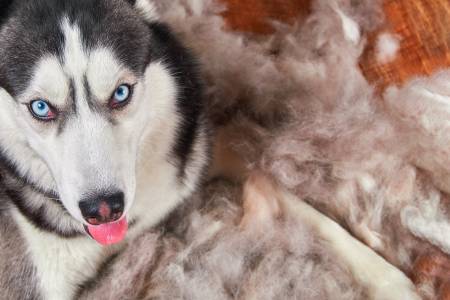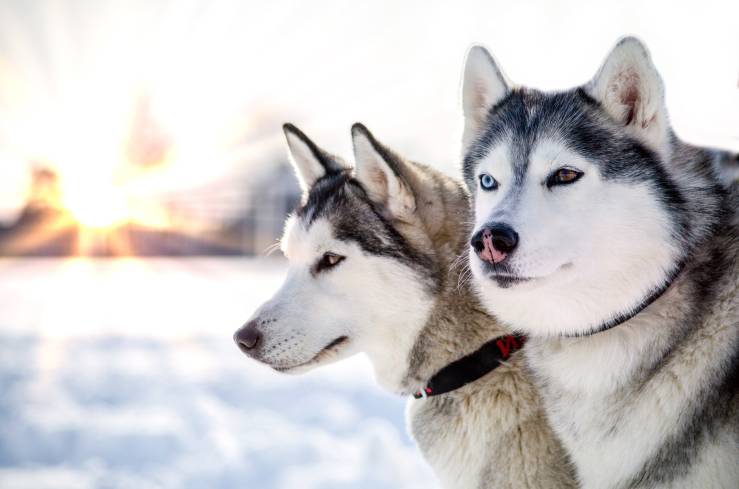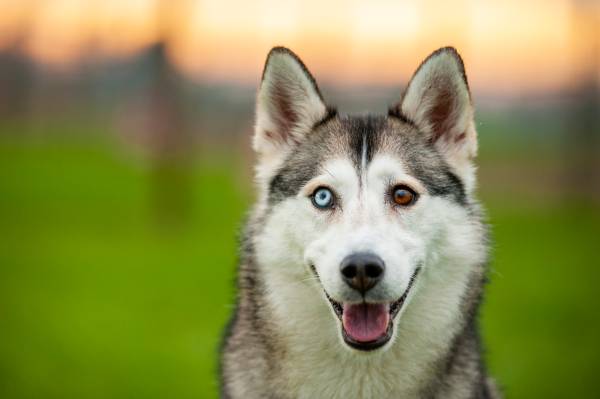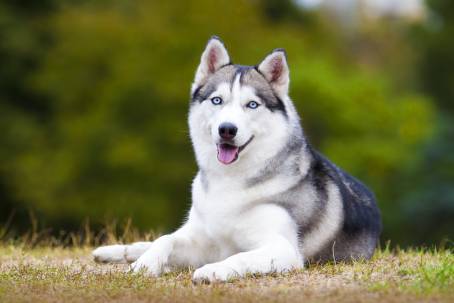Connect with a verified veterinarian in minutes. Licensed vets are available 24/7 to answer your questions. No need to worry about your furry family member.
Huskies are beautiful dogs! There’s no question about that! However, they do have a tendency to shed quite a bit. So, if you’re looking for ways to help control your Husky’s shedding, you’ve come to the right place.
We’ve put some information together about Husky shedding and found tips to help you control your dog’s shedding. Let’s get started!
Why Do Huskies Shed?
Husky’s have a thick, double coat that includes an inner coat. The inner coat is made of short, soft fur that works to insulate the dog from extreme cold weather. The dogs’ outer coat helps shed water and heat, keeping the dogs cooler in warm weather. However, remember these dogs don’t do well in hot, warm climates! They need to live where it’s cooler and/or have access to homes that are air-conditioned in the summer months.
Because Huskies have a double coat, they do shed quite a bit more than other dog breeds. These dogs shed copious amounts during shedding season, which usually comes twice a years. The dogs shed their winter coats in the spring. They then shed again in the fall, as their winter coats come in. During these times, you may think there’s another dog in the house due to all the hair!
In addition, some health conditions may cause a Husky to shed large amounts of fur. Conditions that can cause shedding can include allergies, nutritional deficiencies, parasites, fleas, and more.
So, if you notice your fur baby seems to be losing more hair than normal, it may be time to take him to see the vet.
How Long Do Huskies Shed?
It can take a Husky about 3-5 weeks to shed his coat during the shedding seasons. Some Huskies may shed their fur quicker or longer; it just depends on the dog and the climate.
When your dog starts to shed, you’ll definitely notice the difference! If this is your first shedding season with your fur baby, take note of how long it lasts. Look to see if he follows the same pattern in the next shedding season. If so, then this is your dog’s normal shedding pattern.

Review symptoms, medications & behavior to keep your pets healthy with a Vet Online in just minutes.
Ask a Vet Live NowIs Husky Fur Hypoallergenic?
There’s no such thing as a hypoallergenic dog. Some do believe Huskies are hypoallergenic, but that’s not the case. There’s a myth that says Huskies are hypoallergenic because their fur doesn’t smell and the dogs only shed twice a year. However, this is just a myth.
It’s possible that a person with dog allergies could be allergic to a Husky. It just depends on the specific proteins the person is sensitive to.
The Best Ways to Control Husky Shedding
Now, we’re ready to move on to our tips to help control your Husky’s shedding!
1. Never Cut or Shave Your Husky’s Coat
Dogs that have double coats should never be shaved. Doing so doesn’t affect how much your dog sheds. The problem is that the undercoat grows faster than the topcoat. When the undercoat becomes longer than the topcoat, the result may be a snarled mess of fur for your dog. That’s not comfortable and can cause skin irritation and pulling.
In addition, matted fur keeps your fur baby’s body temperature regulation from working. Your Husky may overheat more easily, which is dangerous during the summer months. Not only that, if the topcoat is too short, the dog can’t shed the heat from the sun and other sources.
So, shaving a Husky’s coat is not a way to control his shedding. It’s harmful to the dog, as he’s not able to regulate his body temperature if his fur is too short.
2. Brush Regularly
One of the best ways to control Husky shedding is regularly brushing your fur baby. Not only is this a time of bonding with your dog, but it can also help manage shedding. Brushing removes dead hair that’s shed from the dog’s coat. Removing this hair regularly helps your dog stay cool and more comfortable. It also helps to stimulate new hair to grow.
Experts recommend brushing your Husky about 4-6 times a week. That’s often enough to help get rid of shed hair. However, brushing too often could cause skin irritation.
You might consider brushing your dog outside on a deck or patio. There the fur is easy to clean up and it’s OK if you don’t clean it all up. Another option is to brush your dog’s hair inside on a floor that’s easy to clean. Avoid brushing your dog on carpeted floor, as this will be a nightmare to clean up. In addition, the carpet can trap dander, which can be bad for people with allergies.
Always aim to keep the experience positive. If you have a young puppy, it’s best to introduce brushing right away and then stay on a regular schedule with brushing. This way, your fur baby becomes used to brushing. And make it a pleasant experience for you both.
3. Use the Right Brushes
The next step to controlling your Husky’s shedding is to use the right brushes! It can be confusing to choose the right brush; however, you can reach out to the vet or groomer. They can help you choose the right brushes for your fur baby.
Most experts recommend using an undercoat rake and a slicker brush (for the topcoat). Both of these brushes can be used during the same session. For instance, you might use the undercoat rake for about 10 minutes and then go over your dog’s topcoat for another 10 minutes (or less).
Starting from the dog’s head and working back toward his backend is usually the best method when it comes to brushing. Once you have the upper area done, then start on the legs and belly. The backside hair can be done at the end of your brushing session, including your canine companion’s tail!
4. Vacuum Regularly
Finally, be sure to vacuum regularly. You may want to buy a vacuum cleaner that’s especially built to handle pet fur. It’s also a good idea to have a vacuum that has a HEPA filter on it, which cuts down on dirt and dander being blown into the room as you vacuum.
Summing It Up
These are the best ways to control your Husky’s shedding! And remember shedding can also be caused by nutritional deficiencies. So, make sure your fur baby has a healthy diet and enough calories to stay healthy.
Along with brushing and diet, regular vacuuming can also help keep the fur down in your home!
Connect with a verified veterinarian in minutes. Licensed vets are available 24/7 to answer your questions. No need to worry about your furry family member.

Kyoko
Kyoko is from a family of 3 and moved to New York with her parents and siblings when she was 13. Kyoko is fond of spending a great amount of time with pets, specifically her beagle Luna and cat Missy. Her boyfriend often complains that she spends too much time giving attention to their animals. Kyoko has written dozens of articles concerning pets and is aiming at owning a pet shop one day!
Review symptoms, medications & behavior to keep your pets healthy with a Vet Online in just minutes.
Ask a Vet Live Now




